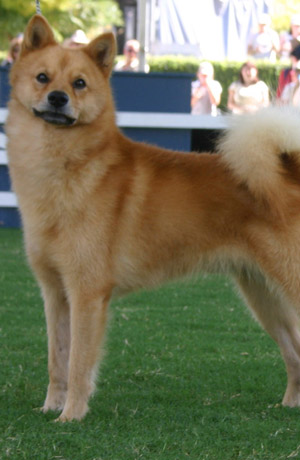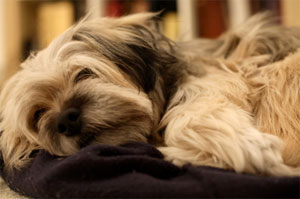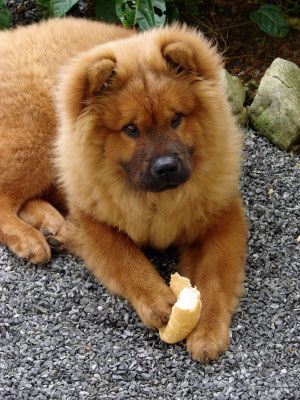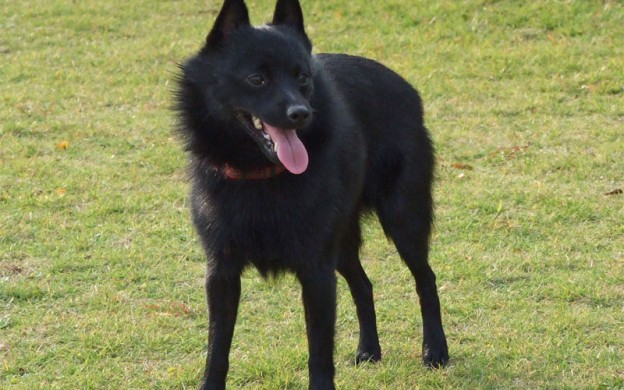
Easily mistaken for a fox due to its beautiful red coat and pointy ears, the Finnish Spitz is a national symbol to be proud of. The Fins appointed it their national dog in 1979, and this gorgeous breed has continued to be a valued member of households, not only in its country of origin, but around the world.
Despite its small size, the Finnish Spitz was originally used as a hunter of small game and birds, as well as larger animals such as moose and elk even bears! It was used mostly as a hunter of birds, however, and would run to the tree where it heard birds flapping, barking to get the attention of its hunter guardian.
Today in Finland, this little Spitz is still used to hunt, but is more common as a household pet both there and around the world.
Rare but remarkable
Barry and Pam Vogt, members of the Victorian Spitz Breed Club, are staunch supporters of the Finnish Spitz and have lived with the breed for the past 22 years. Even back in those early days, the Finnish Spitz was a rarity, and enjoying a challenge, Barry decided he wanted to get involved with this uncommon but special dog.
This breed is very uncommon and is never going to be a popular dog, says Barry, but he adds that once you have owned a Finnish Spitz, its hard to live with any other breed. We have a very long list of people waiting for pups even people from Finland have their names down with us in case one of their dogs dies. They would want to replace it with another as soon as they can.
A clever and alert breed, the Finnish Spitz makes an excellent family pet, but it is fairly independent and strong in character.
You need to be a good dog person to own a Finnish Spitz, Barry claims. This breed can be noisy and difficult if its ignored, but it is extremely affectionate if given time and attention and kept indoors with the family.
From its early days as a hunter, the Finnish Spitz was used to spending long stretches of time with its guardians, living in close contact with them. Still today, this pooch bonds very closely with its family and will become depressed if left to its own devices and not included as one of the pack. The Finnish Spitz needs to be indoors with its guardians and not left out in the yard with no family contact.
Keep it interesting
As with all breeds, the Finnish Spitz should be introduced to training and socialisation during puppyhood, however, because of this breeds intelligence, training should be made interesting and stimulating or this pooch will bore easily and lose interest. This dog is too smart for repetitive training, Barry warns.
Patience is also needed when training this dog, and harsh measures will not work. Rather, positive reinforcement is the way to go.
The Finnish Spitz adores children and makes a great family addition, although it is wary of strangers and will protect its family by warning you of any unusual activity on or near your property. This breed is known for its high-pitched bark, which can become problematic unless nipped in the bud at puppy stage.
Bred to hunt, the Finnish Spitz is an active, athletic breed and still exhibits those instincts today. This canine needs regular daily exercise and its wellbeing depends on being stimulated, both mentally and physically each day. They are known to excel at agility, obedience and field training and have also been used as companion dogs.
Coat care
One of this breeds most eye-catching qualities is its exquisite thick red coat. Born dark grey or fawn in colour, the Spitzs coat begins to turn its beautiful red at about four months of age. Its a double coat with a soft, thick undercoat and longer-haired topcoat. The top layer boasts the beautiful red hue, while the under layer is lighter in colour.
The coat sheds twice a year, and during shedding its important to thoroughly brush out the undercoat so the new coat can grow. If left unbrushed, the dead undercoat will not fall out and can cause skin problems.
Did you know?
As a known hunter of birds and a breed with a high-pitched bark, the Finnish Spitz was given the nickname Finnish Barking Bird-dog.
For more information on the Finnish Spitz or to locate a breeder, contact your state canine council via the Australian National Kennel Council (ANKC) website www.ankc.org.au
In New Zealand, please contact the New Zealand Kennel Club via its website at www.nzkc.org.nz/about.html
Spitz Breed Club Inc (New Zealand): http://spitzbreedsclub.co.nz

Care and exercise
The crowning glory of the Lhasa Apso is, of course, its magnificent coat, which requires daily attention in the form of combing and brushing to keep it at its best and free from mats and tangles. About ten or fifteen minutes each day should suffice. Exercise requirements are not high, as the Apso will get most of what it needs running around the house and yard, but if you take it for a walk, you will tire long before it does!
Suitability
The Lhasa Apso is an excellent choice for anyone wanting a small dog of great beauty and with a somewhat assertive personality, to serve as companion, entertainer and sentinel; and who has the time and desire to undertake the daily grooming to maintain that Apso coat in all its glory.
The Apso is an affectionate, loyal and loving dog that simply adores its family and friends.
This very attractive little dog is one of four breeds originating in and around the monasteries of Tibet, and as well as carrying a glorious coat designed both for beauty and warmth, the Apso also shares the gay, assertive, friendly but sometimes stubborn nature of the others. It may look like a toy breed, but under that long, straight, glamorous coat you will find a sturdy, lithe, active small dog with little interest in being a mere lapdog. Referred to in its homeland (now part of China) as the Lion Dog, the Lhasa Apso for centuries acted as inside watchdog and companion to the monks. A firmly held belief was that priests who failed to reach Nirvana were instead reincarnated as Apsos!
The Apso is an affectionate, loving dog to its family, but can be wary of strangers and unfamiliar situations. It has an acute sense of hearing and makes an excellent burglar alarm. It is an intelligent breed, readily adapting itself to the familys routine and is easily trained if this is done in short sessions. The Apsos playful nature and its enjoyment of human company make it an ideal companion dog, particularly for the older owner. About 25cms at the shoulder and weighing around 7kg, the Apso is quite small, but big enough to make its presence felt when it feels the need. That beautiful long coat is seen in a range of very attractive colours: Gold, sandy, honey, dark grizzle, slate, smoke, black, white, brown, and parti-colour.

The Chow Chow does not have a particularly high exercise requirement, being quite happy with an occasional walk or potter around the backyard. The rough-coated variety, does, however, need a fair bit of regular work on its jacket. This is a very profusely-coated breed, with a harsh, stand-off outer coat and dense, woolly undercoat. Daily brushing and combing are necessary to control mats and tangles and to keep dead hair coming out, particularly at the twice-yearly moult. Bathing a Chow Chow is not the easiest thing to do, because of the amount and thickness of coat, and drying can be a long process. It also makes keeping it free of grass seeds, burrs, etc, a difficulty if the dog spends a lot of time in the yard.
A natural guard and one-person (or one family) dog, the Chow Chow is not suitable for everyone, but it has been said that once you have owned a Chow you will never have another breed. They can be obstinate and self-willed, so early in life their ground rules need to be clearly set. As with any dominant breed of dog, it is vital with the Chow Chow that its owner is established as the pack leader, right from day one. While their need for exercise is minimal, the grooming requirements are high, and this must be taken into consideration before choosing a member of this extraordinary oriental breed.
This addible breed is well known for their teddy-bear qualities. With a loving soft nature and minimal exercise requirements, the Chow is sure to be your next four-legged best friend.
Now, this is a most interesting breed, for several reasons. One, it was bred in China centuries ago for its meat as well as its guarding and hunting ability, two, it has a blue tongue, three, instead of the usual happy doggy expression, it wears a scowl and its straight back legs give it a unique stilted gait.
The Chow Chow is also rather inscrutable and aloof, very much a one-person dog. Behind that rather impassive, thoughtful face, seemingly indifferent to its surroundings, is a personality all its own. Devoted and loyal to the extreme, the Chow can be at times over-protective. It is not a breed to leave running in your front yard. Likened by some to a bear, it is actually more like a lion, with its large head, profuse mane and very solid, strong build. The Chow Chow is most commonly seen in the rough-coated form, but there is also a smooth variety with a short coat.
Average height is around 46-48cm, and weight about 25kg. Both varieties come in a range of solid or shaded colours black, red, blue, fawn, cream or white.

A small, active breed with a fox-like face, the Schipperke makes a wonderful (and different) family companion. By Melinda McHugh.
The Schipperke (pronounced Skipper-key) has been in existence for centuries but its exact origins are unknown. It is probably related to other continental European spitzen such as the German Spitz and Pomeranian, but nobody knows for sure.
What is known is that the breed originally came from the Flemish provinces of Belgium and was later developed into a canal guarder and small-mammal hunter, hence the name Schipperke (which translates to “Little Captain of the Boat”).
The Schipperke was originally employed in Belgium and Holland in the 1600s to work on the barges and keep them free of vermin, as well as to warn the bargemen of potential intruders. The breed was also an efficient rat, rabbit and mole hunter and first appeared at a dog show in 1880. After this time it became popular in Belgian households and after Belgium’s Queen Maria Henrietta acquired a Schipperke at a show in Brussels in 1885, the breed became a fashionable companion. Today the little Schipperke is mostly an ideal household companion but still enjoys using its sea legs and going for the odd fishing trip.
Part of the family
Philip Semmel of the Schipperke Club of Victoria has been breeding Schipperkes since 1997. Philip says the breed is lively, curious and friendly, making it great for families with children.
Clever breed
Due to their intelligence and eager-to-please attitude, Schipperkes are relatively easy to train. “I see training as something to be done through most of any dog’s life and Schipperkes can be trained to achieve remarkable outcomes,” Philip says. “They are rated as a clever breed and that means they can be highly successful, but it also means that techniques for smart dogs have to be used. Basic training can be carried out quite easily and I prefer to see owners join their local obedience club. So far I haven’t heard of Schipperkes in flyball, herding trials or lure coursing, but someone’s bound to take up the challenge in the future. There’s also scope for any member of the family to take up trialling or showing.”
DogsLife is proudly powered by WordPress
